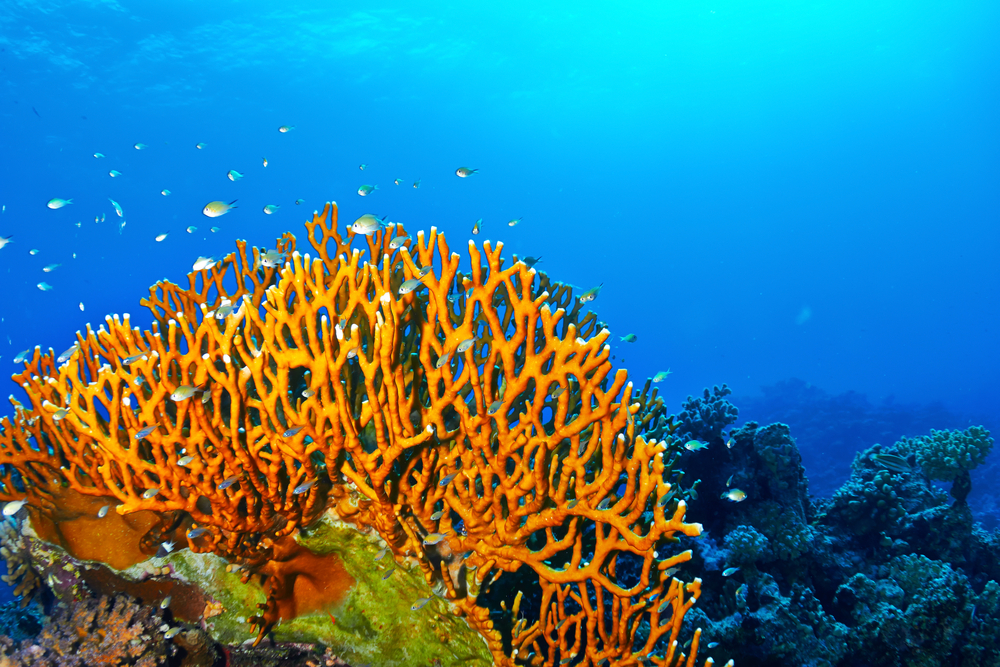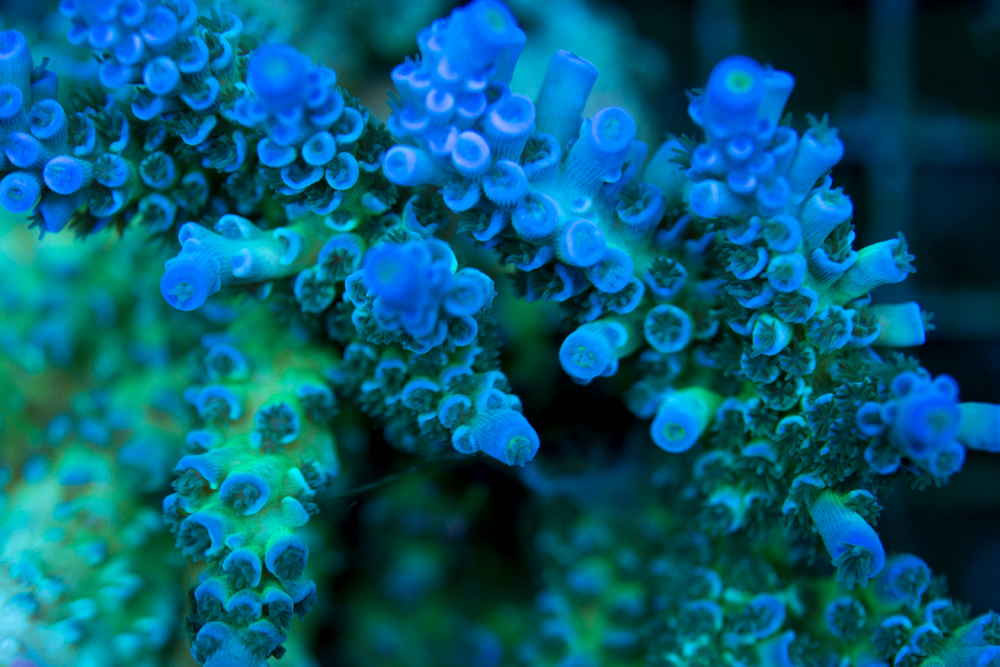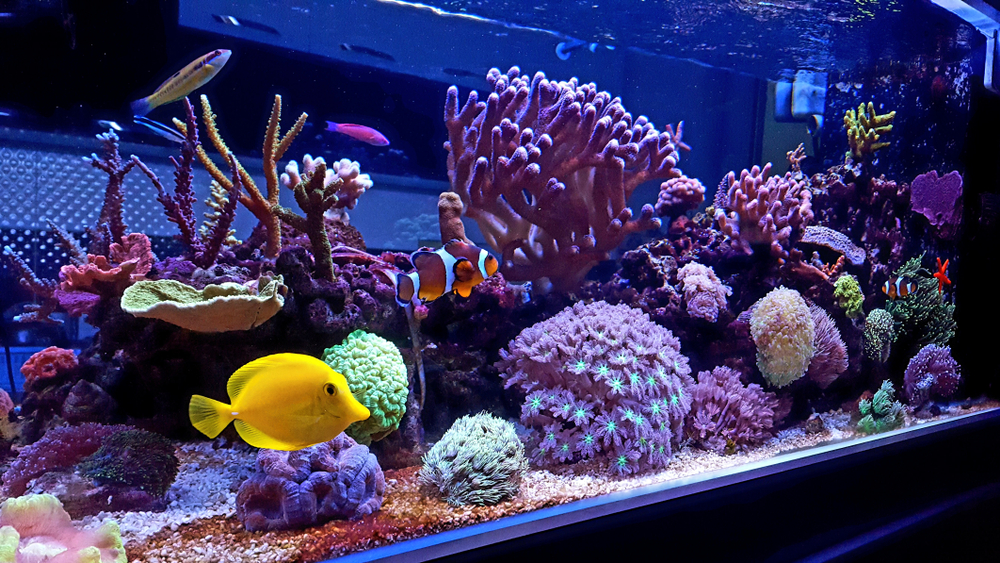A marine aquarium can offer an exciting yet intimidating project for new hobbyists. They demand greater environmental control and require a myriad of equipment to maintain good-quality, temperature-stable, moving water. This, combined with the additional challenge of growing delicate corals and live rocks, means that marine aquaria are often presented as the crème-de-la-crème of fishkeeping. These are the basic principles to get you started on your marine aquarium…
Salts and Salinity
There are two ways of sourcing saltwater for your marine aquarium. Firstly, many aquatic shops will sell premixed salt water for around 25-30p a litre. This might be a straightforward immediate solution, but it is also the costliest. Another option is to buy a bucket of salt, of which there are many different brands and add this to R/O (reverse osmosis) water. R/O water has essentially been treated to turn tap water into 95-99% pure water. There are several ways to do this but a R/O filter can be an excellent investment. Even the average keeper, with just one fish tank, will consistently have to replenish their tank with both R/O and saltwater. For a keeper who has multiple fish tanks, a limitless supply of R/O water will be especially beneficial.
Another benefit of mixing your own saltwater is that the keeper has complete control of the salinity of the water in their marine aquarium. Across the world, the ocean’s salinity varies (sometimes quite drastically). In open seas with a high water exchange, the salinity is likely to be much lower than in enclosed seas, such as the famous dead sea. In tropical areas with lots of rainfall, such as the Philippines, the salinity is likely to be even lower.
Although most fish will be acclimatised to an average ambient salinity once they reach the shop, some species are extremely susceptible to salinity shock. Shrimps, for example, may die if they are introduced to a marine aquarium with different salinity. The more control that the keeper can have over the environmental parameters of the water, the more successful they are likely to be.
Some salts such as ‘Reef Crystals’ will also dissolve in less than 6 minutes. A kilogram of this salt should be enough for 30 litres of water. For most keepers, it is quicker to mix, test and add saltwater themselves than to visit their local shop and transport the water home.
Heat and Movement
A marine aquarium require heating. This heat, much like the filtration system, is a life-support machine for all the aquarium’s inhabitants. Although some species are hardier than others, slight fluctuations in this temperature can cause fish and corals to die relatively quickly. It is, therefore, a good idea to invest in two heaters. Having two 200 watt heaters rather than one 400 watt heater will provide backup should anything go wrong.
The best quality heaters are generally made of quartz instead of glass. They are much hardier and usually have better guarantees. If the keeper only has one heater and it goes wrong during the winter, or while the keeper is on holiday, it can spell doom for the entire marine aquarium. It is therefore advisable that regardless of the experience level of the keeper or the value of the fish, the keeper buys a good quality heater.
Water Clarity, Filtration and Skimmers
Most marine aquariums have a ‘top tank’ and a sump – a hidden body of water containing filtration. This area might also have a skimmer, heater and reactor but it is essentially the mechanical aspect of the tank. If the sump is too small, it may run dry, and the tank will stop circulating.
Some open-top tanks can lose 10-20 litres of water a day through evaporation. Obviously the warmer it is, the more water will evaporate and even the movement of the water can speed up the evaporation process. In this scenario, if the keeper has a 50 litre sump, they only have five days before the sump runs dry. This can be combatted by using an ‘Auto Top-Up’. These are external tanks, filled with R/O water, that will continue to top up the tank over time. Not only does this provide a bigger body of water to support the tank and the sump, but it also balances the salinity level. As an aquarium loses water, it does not lose salt content, thus the salinity increases. So, the automatic addition of more freshwater ensures that the levels are kept constant. Most experienced aquarists would say that an auto top-up is an essential aid in maintaining a successful marine tank.
Even with an auto top-up, keepers should be doing regular saltwater changes. This is to replace the minor trace elements that can be found in all water. It would be impossible to add 0.00001 ppm of most trace elements. They exist in such small quantities that unless more water is added to the marine aquarium, they will be lost over time, especially if there are corals in the tank. These include strontium, iodine, molybdenum, etc. There are 82 trace elements in seawater. Some do not exist in commercial bottles and will not show on a normal testing kit – such as boron, arsenic and even gold. Therefore, the addition of new salt water is the only way to replenish these naturally occurring trace elements.
Calcium, Magnesium and Alkalinity are also important aspects of maintaining a healthy tank and will support the growth of living rocks and corals in your marine aquarium. They are absorbed by the rocks (often very quickly at first) which will deplete the natural elements in the water. These should be replaced using Reef Evolution products or other quality buffers and should stabilise over time. Every aquarium will be slightly different so frequent testing is required to fully understand the process.

Detritus and Algae Build-Up
Any living ecosystem will produce some amount of waste. While the nitrogen cycle should break down the most harmful aspects, unsightly detritus and algae build-up is going to occur no matter how well-kept the marine aquarium is. There are a few helpful tips to reduce this visible waste, beyond having an excellent high-capacity filter.
Firstly, be considerate when feeding frozen foods. Some keepers with multiple tanks will defrost several blocks of brineshrimp or mysis and leave the bag to get warm throughout the day. This process will naturally break down the food and lose the nutritional benefits of the food and add unnecessary detritus to the tank. A more efficient way would be to just drop the block straight into the water on your marine aquarium and allow the fish to pick at the freshly defrosted whole larvae/shrimps/worms.
Secondly, there are various fish which are excellent at cleaning up unwanted algae. Species such as the algae blenny (Salarius fasciatus) will feed ravenously on any algae build-up, even on the surface of the glass. They have a docile temperament and are readily available in most aquatic shops. Bicolor blennies (Ecsenius bicolor), Kole tangs (Ctenochaetus strigosus) and Chevron tangs (Ctenochaetus hawaiiensis) are also great at cleaning glass and rocks. Orange-spot gobies (Valenciennea puellaris) and blue-cheeked gobies (Valenciennea strigata) will also clean algae build-up from the substrate. They take sand in through their mouth and filter it through their gills.
Thirdly, try to install a second wavemaker closer to the substrate, or position the wavemaker towards the substrate. Algae will build up and detritus will often fall to the floor of the marine aquarium and without any water movement to re-position it, both will settle (and it’s not always easy to rectify once the tank is established).
Nitrates and Phosphates
Algae need nitrates and phosphates to grow. The Zooxanthellae and corals need these algae to feed on, so the keeper should aim to maintain a low level of nitrates and phosphates. Without some nitrates and phosphates in the marine aquarium, the coral will lose its colour. Most keepers would suggest nitrate levels of around 15-10 ppm (parts per million), though anything up to 20 ppm is still safe. Phosphate levels vary between keepers but less than 0.02 ppm is the most common standard. Certain corals will demand slightly higher levels of nitrate and phosphate and each keeper is likely to run their marine aquarium slightly differently. For the beginner aquarist, keeping levels as low as possible (but not 0) will help prevent algae build-up and make it easier to achieve an all-around healthy tank. Keepers can also provide specific coral foods to ensure their corals are receiving plenty of nutrients, without the risk of increasing nitrate and phosphate levels.
There are products which help to reduce the amount of nitrate or phosphate in the water. A good-quality protein skimmer can do an excellent job of keeping these levels down. A protein skimmer works by bringing bubbles up towards the surface through a cone, collecting detritus along the way. The bubbles then break, and waste is collected in a basin that surrounds the cone. It is paramount that these are kept clean to allow the bubbles to break at exactly the right level to spit detritus out into the cup.
A good water change will also help to temporarily fix high levels of nitrate and phosphate. The most important thing is that the keeper diagnoses the root of the problem as quickly as possible. Too higher nitrate levels are often due to overfeeding, overstocking, dirty filters, or decaying plant matter.
It is extremely important to test the water in your marine aquarium often. If, when establishing a tank, the keeper is doing weekly water changes and feeding the fish twice a day, testing should be happening every other day.
Nitrogen Cycle
The nitrogen cycle was previously considered a complex aspect of maintaining a marine aquarium. It requires the keeper to prompt the growth of beneficial bacteria by gradually adding a small amount of detritus, or by adding (and feeding) a single fish to produce waste. The small number of bacteria then turn this toxic ammonia into less toxic nitrite and then again into even less toxic nitrate which can be easily removed with a skimmer or water change. Of course, if an aquarium is fully stocked without enough bacteria to break down the ammonia, the fish will quickly succumb to illness. In the past, this was a delicate process and could take over a month before a suitable number of bacteria had built up to maintain the ammonia levels effectively. Nowadays, Dr Tim’s ‘One and Only’ provides all the necessary bacteria in a single bottle. Whilst new hobbyists should familiarise themselves with the nitrogen cycle, most aquarists will use the bottle formula for ease. Some living rock or substrate should be added to help the bacteria multiply over time, but the quicker the bacteria is introduced to the water, the sooner the hobbyist can begin adding fish. These should be added to your marine aquarium gradually (perhaps a new addition each week).
Stocking the Aquarium
There is a whole spectrum of options available when it comes to stocking a marine aquarium. It is the responsibility of the keeper to do thorough investigative research into every species that enters the marine aquarium – including rocks and corals. Like all fishkeeping, not all marine animals will get along, nor thrive under the same conditions as the next.
One tip that may assist new marine keepers, is to avoid anemones. They are very susceptible to changing water quality, will often hide during the early days and if they do die and dissolve, can produce an awful smell that affects the entire marine aquarium. Furthermore, anemones produce stinging spores which are released into the water and can be extremely stressful to most fish species. The same is true for some species of long-tentacled corals (LPS – meaning large-polyp stony).
New keepers should ascertain whether they hope to enter the hobby at an entry-level, by stocking hardier fish and softer corals or at an advanced level with hard corals such as acropora, millepora or macropora. Although things can change over time, the SPS (short-polyp stony) corals are much more expensive and will require better lighting.


If you enjoyed this read, take a look at how you can monitor the health of your fish and help your aquarium thrive here.
